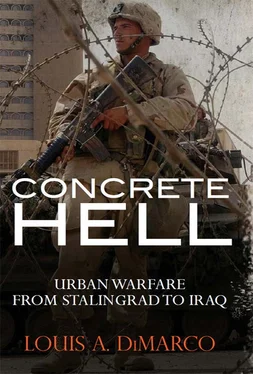Aachen lay in the sector of the German LXXXI Corps, under General der Infanterie Friedrich Köchling. The corps was part of the rebuilt German Seventh Army, part of Army Group B under Field Marshal Walter Model who was tasked by Hitler with stabilizing the situation on the Western Front. The entire front was commanded by the venerable German Field Marshal Gerd von Rundstedt. Having staved off a coup de main seizure of the city in early September, the German command recognized that Aachen had to be held as long as possible for several reasons. First was the importance of the Siegfried Line defenses, two belts of which ran to the east and west of the city. Second, the political symbolism of an ancient German city resisting the Allied assault was extremely valuable propaganda. Finally — and this was a factor which influenced all German operations in the battle — the German counteroffensive planned for the west, Operation Wacht am Rhine, later known as the Battle of the Bulge, was to be launched out of the German Eifel Mountains into the Ardennes forest south of Aachen. A successful penetration at Aachen would place the Allies deep in the northern flank of this planned attack and make it very vulnerable to counterattack.
The German LXXXI Corps defended the Aachen sector with four infantry divisions: the 183rd and 49th Divisions; the 246th Division, which had responsibility for the city itself; and the 12th Division, which defended west of the city in the vicinity of Stolberg. The corps had a number of separate panzer and assault gun units in reserve, notably the 506th Heavy Tank Battalion, equipped with King Tiger tanks. The mission of these mobile forces was to counterattack against any penetration of the infantry division defensive lines. Available, but not released to the corps, was the Army Group B reserve of the 116th Panzer Division and the 3rd Panzer Grenadier Division, both organized under I SS Panzer Corps. Field Marshal von Rundstedt had control of the mobile reserve and would only release it under extreme circumstances.
In early September the German Seventh Army was in disarray and the West Wall defenses were largely unmanned. As the German army retreated, the German command assigned the defense of Aachen to the 116th Panzer Division. This unit, however, was only a shadow of itself after the losses of August. The German commander decided to give up Aachen without a fight. The American VII Corps, however, determined not to attack directly into the city and the 3rd Armored Division leading the corps advance bypassed Aachen to the south and advanced east and northeast beyond the city into the outskirts of the town of Stolberg. Elements of the 3rd Armored were positioned on the western edge of Stolberg when offensive operations ceased to permit priority of supplies to Market Garden in September. As September ended, the US First Army sat immobilized on the German frontier. The VII Corps’ 3rd Armored Division was positioned east of Aachen near Stolberg. The Corps’ 1st Infantry Division was positioned east and south of the city. The boundary between VII Corps and XIX Corps ran roughly through the western portion of the city. North of the city was the area of operations of the 30th Infantry Division whose front generally followed the Wurm River which flowed northwest from northern Aachen.
The battle for Aachen began on October 2, 1944, with the attack of the 30th Infantry Division across the Wurm River, north of Aachen. The American plan was simple, tactically sound, and reflected a solid understanding of urban warfare. The attack involved three divisions and supporting troops. In phase one of the attack, the 30th Division attacked north of the city to drive east and then southeast to secure the town of Wurselen, about 9 miles northeast of the city proper. The 2nd Armored Division supported the attack of the 30th and protected the 30th’s northern flank from counterattack. In the second phase of the attack, the 1st Infantry Division attacked from the south to the north to secure Aachen’s eastern suburbs and to link up with the 30th Division in Wurselen. Phase two’s objective was the complete isolation of the city. The final phase of the attack was an attack by two battalions of the 1st Division’s 26th Infantry Regiment. This attack was from east to west to capture the city center itself. Phase three was timed to occur after the completion of phase two.
At 9am on October 2, the US XIX Corps began its attack with a massive aerial bombardment of German positions, followed closely by an artillery attack which included 26 artillery battalions firing almost 20,000 rounds of ammunition. The 30th Division attacked with two regiments, the 117th and 119th, abreast. The regiments had to penetrate a line of West Wall pillboxes and bunkers, and then attack through a series of small but substantial towns en route to the division’s objective for linkup with VII Corps. Over a period of five days, October 2–7, the two infantry regiments, augmented by reinforcements from the division’s 120th Regiment, made slow but steady progress. The Germans opposed every step of the 30th Division’s advance and each successful American attack was met with a focused German counterattack. General Köchling, the commander of LXXXI Corps, supported by field marshals Model and von Rundstedt, used every available unit in the corps sector to attempt to stop and reverse the American advance. All three of the understrength assault-gun brigades in the corps were used to counterattack the Americans, including the heavy King Tiger tanks of the 506th Heavy Tank Battalion. Infantry battalions were withdrawn from both north and south of the 30th Division penetration to help contain the US attack. An entire infantry regiment and six powerful antitank guns were pulled from Aachen itself to reinforce the forces fighting the 30th Division attack. In addition, the Germans assembled massive amounts of artillery to continually pound the American forward positions and the Wurm River crossing sites.
The Americans met each German counterattack, and the XIX Corps committed the 2nd Armored Division in support of the 30th Division in order to keep the 30th Division’s attack moving and to protect the lengthening north flank of the division. By October 7, the 30th Division had secured Alsdorf and the southern regiment was poised 3 miles from the objective of Wurselen. The German LXXXI Corps had expended all of its resources in its unsuccessful effort to stop XIX Corps’ attack. At that point in the battle the US VII Corps launched its attack.
By October 7, most of the German LXXXI Corps’ reserves were fully committed to the battle. This included all of the mobile elements from the assault-gun brigades, the 108th Panzer Brigade, and the 506th Heavy Tank Battalion. These were impressive formations on paper, but only actually fielded 22 assault guns, four heavy Mark VI (Tiger) tanks, and seven medium Mark V (Panther) tanks. Not an inconsequential force, but only a fraction of what the unit titles represented. It was roughly the size of a weak American armored combat command. On October 5, von Rundstedt released his theater reserves, the rebuilt 116th Panzer Division and the 3rd Panzer Grenadier Division, both divisions under command of the I SS Panzer Corps headquarters, to enter the Aachen battle. The panzer division, though not at full strength, was equipped with 41 Mark IV and V medium tanks. Both divisions had their full complement of infantry, artillery, and antitank guns. It was a significant counterattack force but would take several days to enter the battle.
On October 7, the VII Corps’ 1st Infantry Division occupied positions on the west, south, and east sides of Aachen. The Germans were supplying the city garrison along two highways which entered the city from the north. When the 30th Division captured Alsdorf on October 7 they captured one of the two highways leading into Aachen, leaving the German LXXXI Corps a single line of communications and supply into the city. The 1st Infantry Division was arrayed with all three of its regiments on line over a 12-mile front. From east to west the regiments of the division were aligned with the 16th Infantry Regiment west of Stolberg, the 18th Regiment in the suburbs just east of Aachen proper, and the 26th Regiment bending the line south along the perimeter of the city. The 1st Division’s line was filled south and west of the city by 1106th Combat Engineer Group whose engineer battalions were in the line occupying foxholes as infantry.
Читать дальше












